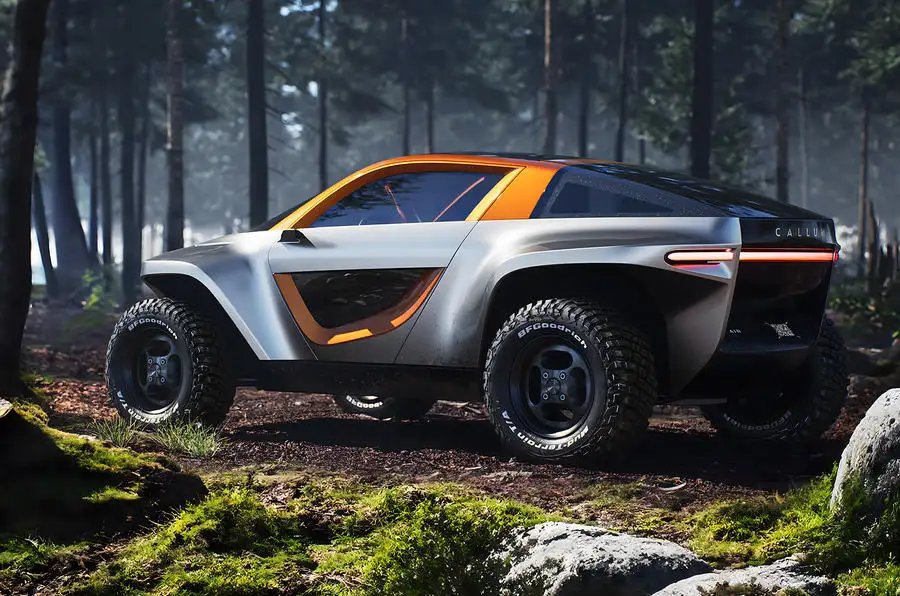Callum Skye is go-anywhere electric sports car for £80,000

The Callum Skye, an electric all-terrain sports car created by ex-Jaguar designer Ian Callum, is now available to order, priced from £80,000.
The first bespoke car from Callum's eponymous design agency has gone on sale just ahead of its public debut at this week's Savile Row Concours in London, having been revealed in digital form late last year.
Prices for the production version range from £80,000 to £110,000, lining the off-road EV up against the similarly conceived Ariel Nomad, which is due to enter its second generation later this year, with an electric option set to follow.
The Skye will be available in two guises: one tailored more towards off-road ability, the other for on-road dynamics.
Callum hasn’t said how many it will make, but it will be an “exclusive” proposition.
Positioned as a compact dual-motor, four-wheel-drive, two-door car with a 50:50 weight distribution, it has a 42kWh battery giving a claimed range of 170 miles and offers the option of a fast charger that can top up the battery in less than 10 minutes.
Measuring 4047mm long and 1900mm wide, the Skye is of a similarly compact footprint to the Renault Clio and Dacia Sandero.
The chassis is a rugged steel spaceframe with plenty of ground clearance and travel for its bespoke all-independent suspension, and it supports a lightweight composite body for a total heft of 1150kg - making this one of the lightest EVs on the market.
The Skye’s bold shape, which the company says is driven by its capabilities, is based on a strong “accent loop” surrounding the door apertures, with a horizontal body structure running through the whole car and providing mountings for the two large doors, which are glazed below the waistline as well as above it.
Callum has also shown the interior of the Skye for the first time, which has been designed to mirror the exterior but with a focus on minimalism. It features a stacked centre console with touchscreen rotary dials to control the heating and ventilation, similar to the Jaguar F-Type. Sitting on top of the dashboard is a central touchscreen, the size of which is not yet known, with smartphone mirroring.
As befits its versatile credentials, the Skye's boot is accessed via a hinged tailgate, and the rear bench - big enough for children - can be removed altogether for additional room. "We've edited our vision to only include necessary design elements, giving the driver and passengers everything they need while avoiding wasted space" said Callum.
The Callum company’s total staff now runs to more than 20 people, although Ian Callum says the firm’s intention is always to remain “small and agile”.
As the first all-new Callum model, the Skye succeeds successful programmes unveiled since the company was founded in 2019, including a highly individualistic reinterpretation of the 2001 Aston Martin Vanquish (an Ian Callum original), a string of impressive forays into product design and some still-secret collaborative projects.
Q&A with Ian Callum, Callum's design chief
Did you consider a sports car as your first own-brand product?
“We did but decided it would be a bit predictable. We settled on something that would show our versatility, and that we’re about all kinds of vehicles, not just one.”
How many Skyes will you make?
“Clearly it depends on demand, but it’ll be dozens, not hundreds. We’re funding the first prototype ourselves, so we have four or five months’ hard work ahead to get it on the road.”
Will you make more bespoke Callum cars?
"That’s our intention. The Vanquish project was something we did to prepare ourselves for the phase that starts with Skye, doing our own projects. We don’t want just to be an agency for other brands. We have a way of creating simple but beautifully crafted cars with special detail design.”
Would you do the next one in bigger numbers?
“There’s lots to do before we get to that kind of decision, but if things go well we could imagine making our own cars in batches of up to 1000. David, Adam and I have been doing this car creation thing together for quite a few years. It’s not a mystery to us; we know our capabilities.”
Electric cars are usually heavy. How are you keeping the weight so low?
What we’ve quoted is a target, but we’re confident we can get close to it by simplifying the design and controlling the weight of every component very closely. This will be a simple machine, beautifully built. Our mantra is ‘minimum mass, maximum capability’.”
Related News


